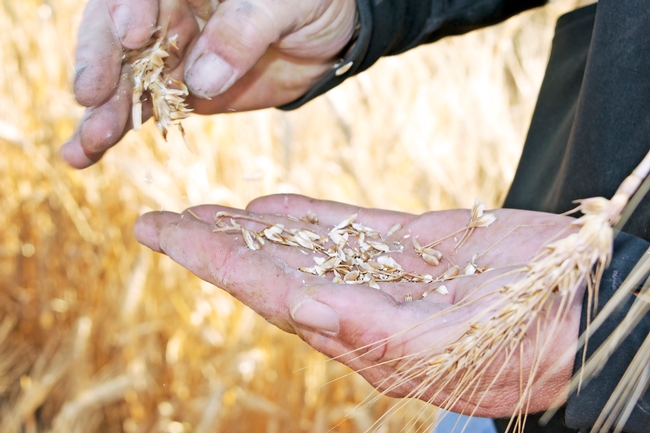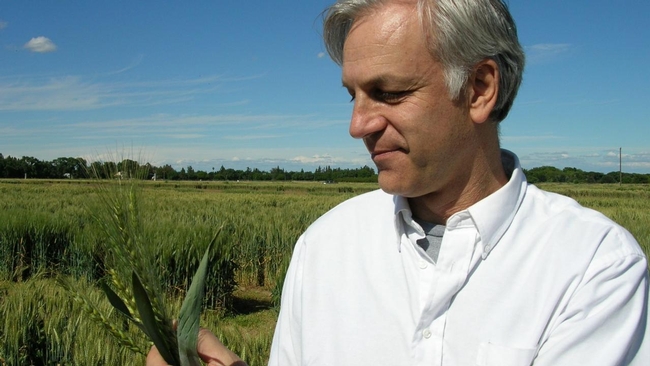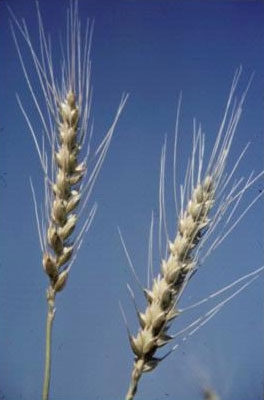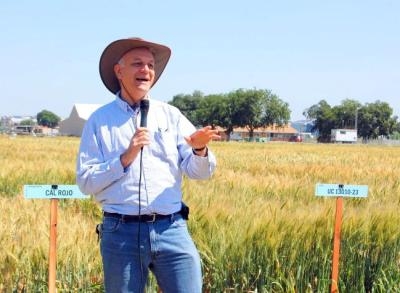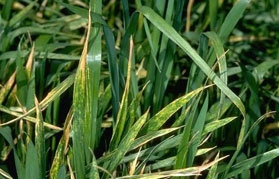Posts Tagged: Jorge Dubcovsky
UC Davis team identifies wheat gene that increases yield
The findings could help growers produce more wheat without expanding operation
A team of scientists from University of California, Davis, have identified a new gene variant in wheat that can increase the amount of the grain produced, new research published in the journal PLOS Genetics finds.
Wheat is a staple of food diets worldwide and the gene discovery could allow farmers to grow more food without increasing land use. Increased yield could also lower consumer prices, making the crop more accessible.
“We have a growing human population that likes to eat every day,” said Jorge Dubcovsky, a plant sciences distinguished professor who led the research. “We need to produce more wheat in the same space so we need plants that are more productive.”
The researchers found a gene – WAPO1 – that controls the maximum number of grains in a wheat spike. Breeding the beneficial gene variant into the plants could delay the formation of the terminal spikelet, providing room for more grains to grow in each spike rather than ending production of grain.
WAPO1 is one of the first genes discovered that can affect wheat yield. “We are trying to make more productive wheat varieties and we are starting to understand how that trait is controlled,” Dubcovsky said.
Pasta wheat lacking the gene
The gene variant for high grain number is found frequently in bread wheats but not in pasta wheats. By breeding the beneficial gene variant into those pasta wheat varieties, growers could increase yield by 4% to 5% in cultivars that have the biomass capacity to fill the extra grains.
“We developed molecular markers to select for the form of that gene to produce increased yield,” Dubcovsky said. “It's a significant step forward.”
Previous research by the team mapped the gene and identified others that could affect yield. This research confirmed those findings for WAPO1.
Discovery on path to future yield increases
The WAPO1 gene is part of a network of genes that work together to control yield, and researchers need to identify the best variant combinations to maximize yield. Solving this puzzle can lead to better production rates.
“We will continue to try to understand the network of genes that control the yield of wheat,” he said.
Saarah Kuzay, Huiqiong Lin, Chengxia Li, Shisheng Chen, Daniel P. Woods and Junli Zhang from UC Davis also contributed to the research, as did scientists from Howard Hughes Medical Institute, Heinrich Heine University and Peking University Institute of Advanced Agricultural Sciences.
Funding was provided by USDAs National Institute of Food and Agriculture's Food Research Initiative, the International Wheat Yield Partnership and Howard Hughes Medical Institute.
GMO fight in southern Oregon sharpens GMO debate in California
"We could do millions of things with transgenics, but we have our hands tied," a story in The Scientist quoted Jorge Dubcovsky, professor in the Department of Plant Sciences at UC Davis.
Dubcovsky commented in The Scientist article about his work in using biotechnology to instill resistance to a devastating plant disease, stripe rust, in wheat.
“Wheat is a very important cereal,” says Ravi Singh of Irrigated Bread Wheat Improvement and Rust Research in Mexico. “Twenty percent of [humans'] calories and about the same [percent of] protein are coming from wheat.”
Genetic engineering is a way to breed long-lasting stem rust–resistant wheat varieties and boost wheat yields around the world. But genetically modified foods are being kept off the market by public opposition and regulatory expenses.
The Scientist article, written by Kerry Grens, said a few groups are forging ahead, including Dubcovsky and other researchers who are cloning stripe rust-resistance genes from wheat and other taxa and identify their functions. For more on Dubcovsky's work, see UC researchers improve wheat nutrition and yield.
UC researchers improve wheat nutrition and yield
The future of the world's food supply looks brighter when you tour the wheat trials underway at UC Davis.
Led by Jorge Dubcovsky, professor in the Department of Plant Sciences at UC Davis and an international expert in wheat breeding and genomics, researchers are decoding the genetic clues that help public and private breeders worldwide develop wheat varieties that resist disease, tolerate drought, and provide even greater nutrition.
"Nobody else is doing the extensive wheat research they conduct at UC Davis," said Patrick Klinger, a grain distributor with both the international agribusiness firm Wilbur-Ellis and Blair Grain Company in Stockton. "If they weren't doing it, it wouldn't get done."
Klinger was one of the few hundred growers, breeders, seed distributors and others who attended a recent Small Grains Field Day at UCD where the latest developments in wheat and other grains were on display. They toured test plots west of campus where Dubcovsky and his team are growing various wheat plants, examining them to find material that can be used to breed better varieties.
Wheat is one of the most important crops worldwide, accounting for 20 percent of what humans eat every day. Making wheat more nutritious and adaptable to different environments has a big impact on feeding the world's growing population.
In California, wheat is a primary crop for many producers and a valuable rotation crop, helping manage disease and improve the condition of the soil. California growers produce about 1.1 million tons of wheat each year for human and animal consumption, with a total value of $337 million.
Dubcovsky's lab has forged new territory in wheat genetics — mapping, isolating, and cloning developmental genes from the plant's huge, unsequenced genome. In 2006, Dubcovsky discovered a way to boost protein, zinc and iron in cultivated wheat by bringing back from wild wheat a gene that move nitrogen and other nutrients faster and more efficiently from leaf to grain, ferrying additional nutrients into the seed before the plant dies. Almost all modern wheat varieties have a defective copy of this gene.
And that was just the beginning of his in-depth, molecular investigation into the plant's aging process. Dubcovsky's lab currently supports 13 graduate students helping investigate critical stages of wheat's development cycle, cloning genes involved in drought tolerance, spike development, and disease resistance.
"The more we understand about how genes modify theses processes, the better equipped we are to breed varieties that are matched to a changing climate, and even produce more grains per spike," Dubcovsky said.
During the recent tour, Dubcovsky's lab presented promising work with isolating genes resistant to stripe rust, a devastating wheat disease; genes that allow wheat to flower a few days early, thus saving precious irrigation water; genes that allow wheat to tolerate drought conditions; and genes that increase fiber-like resistant starch in wheat.
Resistant starch is resistant to digestion, and behaves as additional fiber. Resistant starch has powerful health benefits, including reduced rates of obesity, diabetes, heart disease and cancer.
"We're working to increase the percentage of resistant starch to other starch in wheat," said Brittany Howell, a doctoral student in Dubcovsky's lab. Through her breeding efforts, Howell has already increased resistant starch in wheat by 600 to 700 percent.
During his 18 years at UCD, Dubcovsky and his program have released eight wheat varieties, five others in collaboration with industry, and 30 germplasm, all designed to solve specific issues with environment, disease, yield and nutrition. A new variety of Hard Red Spring wheat, resistant to stripe rust, will likely be released next year. The stripe rust-resistant varieties are now being field tested by UC Cooperative Extension advisors.
All of Dubcovsky's research, varieties and genetic material are publically available for breeders and researchers around the world to expand upon and use.
"Yes, we like to share and collaborate," Dubcovsky said. "Better science makes better wheat. And better wheat reduces hunger and poverty, and improves people's lives around the world."
Dubcovsky is a 2014 winner of the Wolf Prize in Agriculture, awarded each year to the world's most outstanding scientists working in agriculture. He's a member of the National Academy of Sciences, and a Howard Hughes Medical Institute and Gordon and Betty Moore Foundation investigator.
First draft of genome of wheat stripe rust published in Public Library of Science
UC Davis Department of Plant Sciences researchers are the leading authors of an article published in the journal Public Library of Science which presents a first draft of the genome of wheat stripe rust (Puccinia striiformis), one of the most devastating pathogens of wheat.
The stripe rust disease of wheat caused by the highly specialized fungal pathogen Puccinia striiformis f. sp. tritici has been responsible for recurrent episodes of large yield losses and economic hardship among grain-based agricultural societies for centuries. Current epidemics of new aggressive races of Puccinia striiformis that appear after the year 2000 pose significant threats to food security worldwide and, in particular, in developing countries in Africa and central Asia. In spite of its economic importance, the Puccinia striiformis genomic sequence is not currently available.
In order to get access to the genes of this pathogen, a team of researchers – including Professor Jorge Dubcovsky (also a Howard Hughes Medical Institute researcher) and Professor Richard Michelmore, director of the UC Davis Genome Center, Project Scientist Dario Cantu and Manjula Govindarajulu, a postdoctoral researcher in Michelmore’s lab - used cutting-edge technology to rapidly sequence a large portion of the genome of one of the Puccinia striiformis more virulent and aggressive races. They assembled long stretches of the Puccinia striiformis genome and established a preliminary automatic annotation of its genes, with a special focus on those likely to be involved in pathogenicity.
This information is available in the open-access article published by the Public Library of Science and made publically available through the National Center of Biotechnology information and a dedicated web page.
“This shotgun sequence assembly does not substitute for the need of a complete and annotated Puccinia striiformis genome, but it provides immediate access to a large proportion, more than about 88 percent, of the genes from this pathogen,” said Cantu. “This public information has the potential to accelerate a new wave of studies to determine the mechanisms used by this pathogen to infect wheat, and hopefully to reduce current yield loses caused by this pathogen.”
These researchers, in collaboration with others at the John Innes Institute in the UK, are currently sequencing new and old races of Puccinia striiformis to investigate their differences in virulence and aggressiveness.
This project was supported in part by funds provided through a grant from the Bill & Melinda Gates Foundation, and the National Research Initiative Competitive Grants from the USDA National Institute of Food and Agriculture.
New funding to study wheat and forest genetics
Roger Beachy, the director of the USDA National Institute of Food and Agriculture, was at UC Davis yesterday to announce grants for agricultural research amounting to $40 million, calling them "significant investments," said a UC Davis news release.
Together with UC Davis officials, Beachy announced that:
- Wheat geneticist Jorge Dubcovsky will receive $25 million to develop new varieties of wheat and barley. Dubcovsky and his 55 university and USDA colleagues will focus on biological and environmental stresses to wheat that are caused, at least in part, by global climate change.
- Forest geneticist David Neale will receive $14.6 million to head a team that will work to sequence the genomes of loblolly pine and two other conifers. Neale and his research colleagues plan to accelerate breeding efforts for fast-growing varieties of these trees to enhance their use as feedstocks for biofuels and biopower.
"We look forward to the practical solutions for agriculture and for the environment that will arise from these collaborative projects," UC Davis Chancellor Linda Katehi said at the press conference.
A story about the grants written by Rick Daysog of the Sacramento Bee said they come as UC Davis has stepped up efforts to attract research grants following Katehi's appointment as chancellor in 2009. During its fiscal year ending June 30, 2010, the university received a record $679 million in research grants.

Left to right: David Neale, Jorge Dubcovsky, Linda Katehi, Roger Beachy, Neal Van Alfen.

